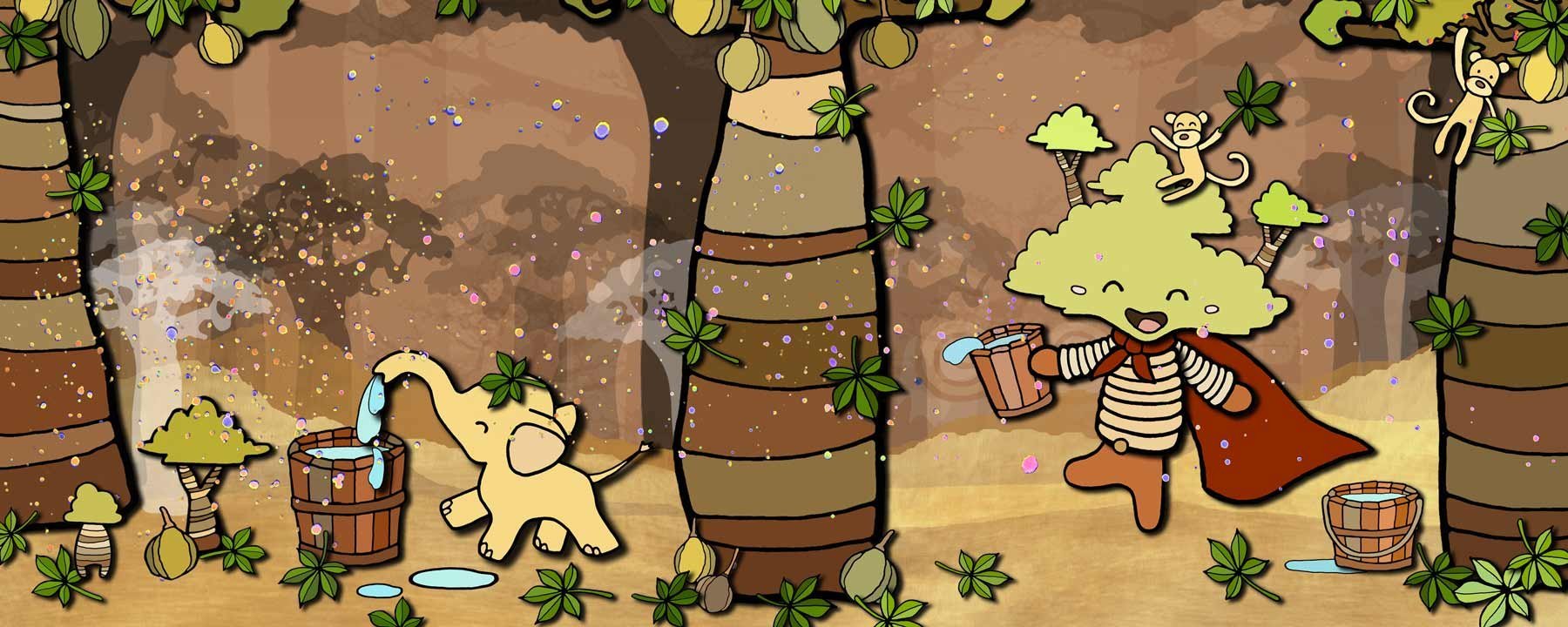Bountiful Baobab is a bulbous tree with boundless energy and an abundant imagination. It is a guardian tree that is loved by animals, insects, and birds of all types for its generous spirit and seemingly boundless gifts. A 200-year-old Baobab is considered young because they can live to be 1000 – 2500 years old and reach heights of 100 feet. Bountiful Baobab’s soft, shiny belly bulges when it soaks in the rain during the rainy season. They grow so fat sometimes that they become hollow inside, creating a water tower. Baobab’s palmate leaves only come out during the rainy season and its large white flowers only bloom at night. Every part of Bountiful Baobab is edible including its seeds, leaves, flowers, fruit, roots and bark.
Bountiful Baobab sharing some water.
Bountiful Baobab’s Family: Bountiful Baobab, Adansonia digitata, lives in Botswana, Africa, where it has grown for 200 million years. The name digitata refers to the fact that its finger-like leaves resemble a hand. Baobab’s extended family includes eight different species that live in the hot, dry areas of Africa, Australia, Madagascar, Arabia and India. The name “baobab” is Arabic for “father of many seeds.” Its seeds, contained within its fruit, are consumed by birds and animals who distribute them over long distances. Common names for Baobab are monkey-bread tree, wooden elephant, upside-down tree and the cream of tartar tree. Baobab is a member of the enormous Malvaceae (Mallow) family that has 243 genera that includes cacao, hibiscus, cotton and kola, to name just a few.
Growing Climate: Arid Savannas
Botanical Lineage:
Species: Adansonia digitata (Digit Baobab)
Genus: Adansonia (Baobab)
Family: Malvaceae (Mallow family)
The Baobab is called Africa’s “Tree of Life.” It is a prehistoric species that dates back 200 million years, before the supercontinent of Pangea split apart. A mature baobab tree is a living ecosystem that can store thousands of gallons of water in its trunk and can live to be 2500 years old. Communities are created around baobabs because of their ability to sustain and endure where little else lives. Its fruit, called Monkey Bread, is about the size of a large coconut that provides calcium, magnesium, iron, zinc, riboflavin, potassium, Vitamin C and carbohydrates. Its flavor is described as a cross between grapefruit and pear with a hint of vanilla. Baobab fruit can naturally dry on the tree and will preserve itself for up to three years. Its pulp has been used as a traditional source of medicine for fevers, pain and diarrhea. The dried fruit can be turned into powder that is rich in antioxidants. Its seeds can be ground like coffee beans or pressed into oil. Fiber from the bark is pounded to make rope, cloth, nets, baskets and paper. Its leaves are eaten like lettuce and glue is made from the pollen. If they are burned or stripped of their bark, they typically form new bark and keep on living. Mature baobab trees become hollow with age and can function as shelters that have held up to 40 people. During extreme drought they simply dry out and evaporate, causing them to dramatically collapse in on themselves within hours and leaving little trace of their existence.
New Book Coming Soon!
Title: Bountiful Baobab – An African Adventure
Storyline: Bountiful Baobab invites Truthful Tea Leaf and Blissful Bodhi to an overnight adventure in Africa. When Tea Leaf and Bodhi arrive, they are greeted by Bountiful Baobab and a babbling baboon who is holding baskets of monkey bread fruit. As they eat the fruit, a herd of zebras run by to say hello. After dinner they are introduced to an elder Baobab that has been turned into a cottage with windows that contains two beds. When the sun sets, they hear a lazy lion roaring as it lays down to go to sleep outside their window. During the night Baobab’s flowers open and busy fruit bats begin buzzing around gathering pollen. In the morning they awaken to the sound of eager elephants standing outside their door looking for water. The friends take a short walk and meet a gentle giraffe who plucks a flower for them to smell. A curious cheetah lets them know how lucky they are to have Bountiful Baobab for a friend. An ogling ostrich scratches the ground looking for insects, as hovering honey bees deliver honey for afternoon tea. Soon it’s time for Tea Leaf and Bodhi to return home. All of their new friends gather around the portal to wish them well.
Copyright © 2021 by Lanvi T. Nguyen and Laural V. Wauters.
All rights reserved.
